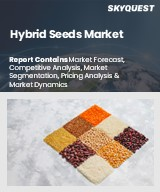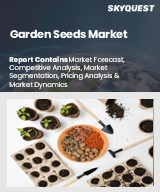
|
시장보고서
상품코드
1577064
하이브리드 종자 시장, 기회, 성장 촉진요인, 산업 동향 분석과 예측(2024-2032년)Hybrid Seeds Market, Opportunity, Growth Drivers, Industry Trend Analysis and Forecast, 2024-2032 |
||||||
세계의 하이브리드 종자 시장은 2023년에는 약 560억 달러로 평가되며, 2032년에는 CAGR 7.8%로 1,098억 달러에 달할 것으로 예측됩니다.
하이브리드 종자는 생산성 향상, 수확량 증가, 수익성 향상을 가져옵니다. 다양한 질병과 해충에 대한 내성이 있으며, 작물 손실을 최소화하고 화학 농약에 대한 의존도를 줄일 수 있습니다. 이러한 장점은 예측 기간 중 하이브리드 종자 시장의 성장을 가속할 것으로 예상됩니다. 유전자 변형과 종자 육종의 발전으로 인해 수확 잠재력이 강화되고 질병 저항성이 향상되어 다양한 환경 조건에 적응할 수 있는 하이브리드 종자를 쉽게 생산할 수 있게 되었습니다.
대규모 상업 농장 부문은 2032년까지 560억 달러를 획득하며, CAGR은 7.9%에 달할 것으로 예측됩니다. 이 분야는 작물의 수익성을 극대화하는 것을 우선시하는 대규모 상업용 농장에서 하이브리드 종자에 대한 강력한 수요로 인해 빠르게 성장하고 있습니다. 하이브리드 종자는 수확량 증가와 이익 증가에 기여하여 상업적 농업 기업의 목적에 부합합니다. 농장 규모는 하이브리드 종자 시장의 도입 추세를 형성하는 데 중요한 역할을 하고 있으며, 대규모 상업용 농장이 주요 사용자입니다. 이러한 경영은 높은 생산성과 안정적인 작황을 요구하므로 하이브리드 종자는 이상적인 선택이 될 수 있습니다.
시장은 유통 채널에 따라 직접 판매, 농자재점, 온라인 소매, 협동조합, 기타로 구분됩니다. 직접 판매은 2023년 약 40%의 주요 시장 점유율을 차지할 것으로 예상되며, 2032년까지 급성장할 것으로 전망됩니다. 직거래를 통해 고객은 종자회사로부터 최신 하이브리드 종자를 직접 조달할 가능성이 있습니다. 최신 기술에 정통한 농업 종사자들은 직거래 경로를 통해 종자를 구매하는 것을 선호합니다. 종자회사는 직거래를 이용하는 고객에게 기술 지원 및 농업학적 조언과 같은 보완적인 서비스를 제공합니다. 이러한 지원은 종자 선택, 작물 관리 및 재배 방법에 대한 올바른 결정을 내리는 데 도움이 되며, 직거래 채널을 통한 하이브리드 종자에 대한 높은 수요를 창출하고 있습니다.
북미 시장은 2023년 194억 달러 규모로 2024-2032년 급성장할 것으로 예상됩니다. 북미 농가는 국내 및 국제 시장에서 작물 수확량과 수익성 확대에 주력하고 있습니다. 하이브리드 종자는 더 높은 생산성과 매출 증가를 제공하여 기존 종자보다 선호되고 있습니다. 북미에서 유행하는 수많은 작물 병해에 대한 내성이 하이브리드 종자 시장의 성장을 적극적으로 촉진하고 있습니다.
목차
제1장 조사 방법과 조사 범위
제2장 개요
제3장 업계 인사이트
- 에코시스템 분석
- 주요 제조업체
- 유통업체
- 업계 전체의 이익률
- 업계에 대한 영향요인
- 촉진요인
- 바이오테크놀러지의 채택 확대
- 수량 향상과 생산성의 중시
- 영양 강화법
- 시장이 해결해야 할 과제
- 제품의 고비용
- 특허와 라이선싱
- 자연재해
- 시장 기회
- 새로운 기회
- 성장 가능성 분석
- 촉진요인
- 원재료 상황
- 제조 동향
- 기술의 진화
- 지속가능 제조
- 그린 프랙티스
- 탈탄소화
- 지속가능 제조
- 원재료의 지속가능성
- 가격 동향(달러/톤), 2021-2032년
- 규제와 시장에 대한 영향
- Porter의 산업 분석
- PESTEL 분석
제4장 경쟁 구도
- 기업 점유율 분석
- 경쟁 포지셔닝 매트릭스
- 전략 전망 매트릭스
제5장 시장 규모·예측 : 농장 유형별, 2021-2032년
- 주요 동향
- 대규모 상업 농장
- 소규모 농장
- 계약 농가
제6장 시장 규모·예측 : 유통 채널별, 2021-2032년
- 주요 동향
- 직판
- 온라인 소매
- 농업 자재점
- 협동조합
- 기타
제7장 시장 규모·예측 : 작물 유형별, 2021-2032년
- 주요 동향
- 옥수수
- 쌀
- 밀
- 대두
- 면화
- 카놀라
- 채소
- 과일
- 기타
제8장 시장 규모·예측 : 특성별, 2021-2032년
- 주요 동향
- 곤충 저항성
- 병해 저항성
- 제초제 내성
- 생물 스트레스 내성
- 수량 향상
- 품질 향상
- 기타
제9장 시장 규모·예측 : 지역별, 2021-2032년
- 주요 동향
- 북미
- 미국
- 캐나다
- 유럽
- 독일
- 영국
- 프랑스
- 이탈리아
- 스페인
- 기타 유럽
- 아시아태평양
- 중국
- 인도
- 일본
- 한국
- 호주
- 기타 아시아태평양
- 라틴아메리카
- 브라질
- 멕시코
- 아르헨티나
- 기타 라틴아메리카
- 중동 및 아프리카
- 사우디아라비아
- UAE
- 남아프리카공화국
- 기타 중동 및 아프리카
제10장 기업 개요
- Corteva Agriscience
- Syngenta AG(part of ChemChina)
- Bayer CropScience(part of Bayer AG)
- BASF SE, Groupe Limagrain
- KWS SAAT SE
- DowDuPont Inc.(now Dow Inc. and DuPont de Nemours, Inc.)
- Monsanto Company(now part of Bayer CropScience)
- Sakata Seed Corporation
- Zwaan Zaadteelt en Zaadhandel B.V.
- Land O'Lakes(WinField United)
- Rijk Zwaan
- Takii and Co. Ltd.
- Vilmorin and Cie
- East-West Seed
- Groupe Roullier
The Global Hybrid Seeds Market was valued at approximately USD 56 billion in 2023 and is projected to reach USD 109.8 billion by 2032, with a CAGR of 7.8%. Hybrid seeds provide improved productivity, higher yields, and greater profitability. Their resistance to various diseases and pests helps minimize crop losses and reduces the reliance on chemical pesticides. These advantages are expected to drive the growth of the hybrid seeds market throughout the forecast period. Advances in genetic modification and seed breeding are facilitating the creation of hybrid seeds with enhanced yield potential, better disease resistance, and adaptability to a wide range of environmental conditions.
The overall hybrid seeds industry is classified based on the farm type, distribution channel, crop type, trait, and region.
The large-scale commercial farms segment is projected to capture USD 56 billion and demonstrate a 7.9% CAGR by 2032. This segment is growing rapidly due to the strong demand for hybrid seeds in large-scale commercial farms, which prioritize maximizing crop profitability. Hybrid seeds contribute to higher yields and increased profits, aligning with the objectives of commercial farming enterprises. Farm size plays a crucial role in shaping adoption trends in the hybrid seeds market, with large-scale commercial farms being the primary users. These operations require high productivity and consistent crop performance, making hybrid seeds an ideal choice.
Based on distribution channels, the market is segmented into direct sales, Agri-input stores, online retail, cooperative societies, and others. Direct sales held a major market share of around 40% in 2023 and are anticipated to grow rapidly by 2032. Through direct sales, customers can procure the latest hybrid seeds directly from seed companies. Agriculturists who are more aware of the latest technologies prefer these seeds from direct sales channels. Seed companies offer complementary services, such as technical support and agronomic advice, to customers who resort to direct sales. This assistance helps them make the right decisions related to seed selection, crop management, and planting practices, generating high demand for hybrid seeds through direct sales channels.
The North America market accounted for USD 19.4 billion in 2023 and is predicted to grow rapidly from 2024 to 2032. North American farmers focus on expanding their crop yield and profitability in both domestic and international markets. Hybrid seeds offer higher productivity and increased profits and are preferred over traditional seeds. Their resistance to numerous crop diseases prevalent in North America positively drives the hybrid seeds market growth.
Table of Contents
Chapter 1 Methodology and Scope
- 1.1 Market scope and definition
- 1.2 Base estimates and calculations
- 1.3 Forecast calculation
- 1.4 Data sources
- 1.4.1 Primary
- 1.4.2 Secondary
- 1.4.2.1 Paid sources
- 1.4.2.2 Public sources
Chapter 2 Executive Summary
- 2.1 Industry 360° synopsis
Chapter 3 Industry Insights
- 3.1 Industry ecosystem analysis
- 3.1.1 Key manufacturers
- 3.1.2 Distributors
- 3.1.3 Profit margins across the industry
- 3.2 Industry impact forces
- 3.2.1 Growth drivers
- 3.2.1.1 Increasing adoption of biotechnology
- 3.2.1.2 Focus on yield enhancement and productivity
- 3.2.1.3 Nutritional enhancement methods
- 3.2.2 Market challenges
- 3.2.2.1 High cost of products
- 3.2.2.2 Patents and licensing
- 3.2.2.3 Natural hazards
- 3.2.3 Market opportunity
- 3.2.3.1 New opportunities
- 3.2.3.2 Growth potential analysis
- 3.2.1 Growth drivers
- 3.3 Raw material landscape
- 3.3.1 Manufacturing trends
- 3.3.2 Technology evolution
- 3.3.2.1 Sustainable manufacturing
- 3.3.2.1.1 Green practices
- 3.3.2.1.2 Decarbonization
- 3.3.2.1 Sustainable manufacturing
- 3.3.3 Sustainability in raw materials
- 3.3.4 Pricing trends (USD/Ton), 2021 - 2032
- 3.3.4.1 North America
- 3.3.4.2 Europe
- 3.3.4.3 Asia Pacific
- 3.3.4.4 Latin America
- 3.3.4.5 Middle East and Africa
- 3.4 Regulations and market impact
- 3.5 Porter's analysis
- 3.6 PESTEL analysis
Chapter 4 Competitive Landscape, 2023
- 4.1 Company market share analysis
- 4.2 Competitive positioning matrix
- 4.3 Strategic outlook matrix
Chapter 5 Market Size and Forecast, By Farm Type, 2021-2032 (USD Billion, Tons)
- 5.1 Key trends
- 5.2 Large-scale commercial farms
- 5.3 Small-scale farms
- 5.4 Contract farming
Chapter 6 Market Size and Forecast, By Distribution Channel, 2021-2032 (USD Billion, Tons)
- 6.1 Key trends
- 6.2 Direct sales
- 6.3 Online retail
- 6.4 Agri-input stores
- 6.5 Cooperative societies
- 6.6 Others
Chapter 7 Market Size and Forecast, By Crop Type, 2021-2032 (USD Billion, Tons)
- 7.1 Key trends
- 7.2 Corn
- 7.3 Rice
- 7.4 Wheat
- 7.5 Soybean
- 7.6 Cotton
- 7.7 Canola
- 7.8 Vegetables
- 7.9 Fruits
- 7.10 Others
Chapter 8 Market Size and Forecast, By Trait, 2021-2032 (USD Billion, Tons)
- 8.1 Key trends
- 8.2 Insect resistance
- 8.3 Disease resistance
- 8.4 Herbicide tolerance
- 8.5 Abiotic stress tolerance
- 8.6 Yield enhancement
- 8.7 Quality improvement
- 8.8 Others
Chapter 9 Market Size and Forecast, By Region, 2021-2032 (USD Billion, Tons)
- 9.1 Key trends
- 9.2 North America
- 9.2.1 U.S.
- 9.2.2 Canada
- 9.3 Europe
- 9.3.1 Germany
- 9.3.2 UK
- 9.3.3 France
- 9.3.4 Italy
- 9.3.5 Spain
- 9.3.6 Rest of Europe
- 9.4 Asia Pacific
- 9.4.1 China
- 9.4.2 India
- 9.4.3 Japan
- 9.4.4 South Korea
- 9.4.5 Australia
- 9.4.6 Rest of Asia Pacific
- 9.5 Latin America
- 9.5.1 Brazil
- 9.5.2 Mexico
- 9.5.3 Argentina
- 9.5.4 Rest of Latin America
- 9.6 MEA
- 9.6.1 Saudi Arabia
- 9.6.2 UAE
- 9.6.3 South Africa
- 9.6.4 Rest of MEA
Chapter 10 Company Profiles
- 10.1 Corteva Agriscience
- 10.2 Syngenta AG (part of ChemChina)
- 10.3 Bayer CropScience (part of Bayer AG)
- 10.4 BASF SE, Groupe Limagrain
- 10.5 KWS SAAT SE
- 10.6 DowDuPont Inc. (now Dow Inc. and DuPont de Nemours, Inc.)
- 10.7 Monsanto Company (now part of Bayer CropScience)
- 10.8 Sakata Seed Corporation
- 10.9 Zwaan Zaadteelt en Zaadhandel B.V.
- 10.10 Land O'Lakes (WinField United)
- 10.11 Rijk Zwaan
- 10.12 Takii and Co. Ltd.
- 10.13 Vilmorin and Cie
- 10.14 East-West Seed
- 10.15 Groupe Roullier

















